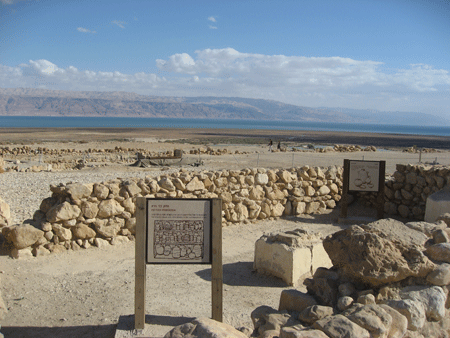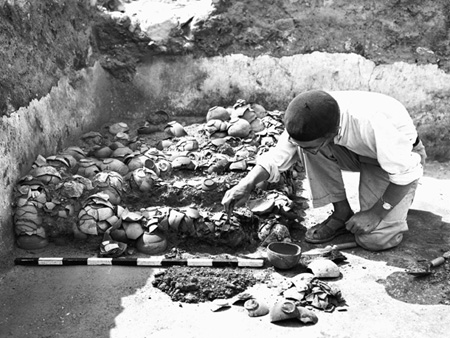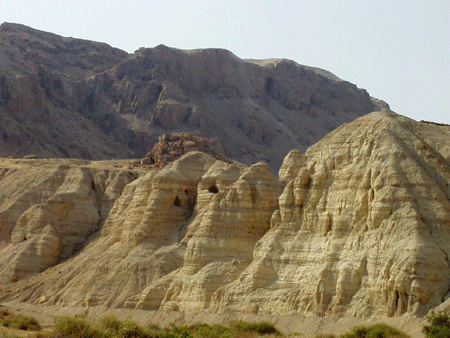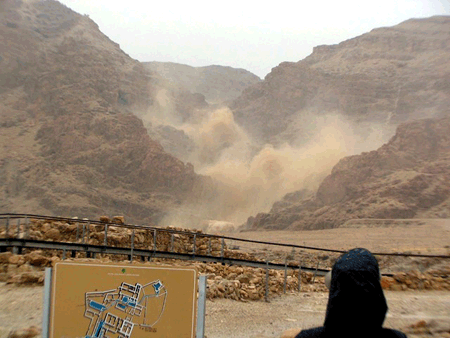|
 |
| |
| Last August the
thermometer of our bus in the Qumran parking lot
read 48 degrees. That’s 118 degrees Fahrenheit!
As I sat with my small group of Californians under
the shade netting opposite cave number 4, the heat
was almost bearable. What astounded me is that
my pilgrims were so engrossed in the story of the
Dead Sea Scrolls, they didn’t seem to take notice of
the heat. |
|
|
Question followed comment, as we explored the
relationship of John the Baptist to the group of
protestors (we think) who fled Jerusalem to
establish a retreat center in the wilderness of
Judea opposite the Dead Sea.
Unlike Christianity in which the disciples and
followers from the very beginning organized around
one charismatic leader, the Qumran sect was
initially a loose, unstructured group. They
eventually united around one leader whom they called
the teacher of righteousness. |
|
|
| At Qumran itself,
there weren't more than a few hundred people.
Members of the sect were male and most carried on a
normal lifestyle, scattered throughout the towns and
villages of Judea. They married at age 20 and
lived within the family unit until age 30.
Then they would retreat for a 10-year period of
service, dwelling in huts or caves in the vicinity
of Qumran, their monastic-type center perched on a
plateau overlooking the Dead Sea. Josephus, first
century AD historian, called this sect Essenes. |
|
|
|
 |
|
Photo: Gila
Yudkin |
|
View of the Essenes' kitchen at
Qumran -- and see photo below |
|
|
|
 |
|
Courtesy of
the Israel Antiquities Authority |
|
Excavator Josef Milik
examining bowls and goblets in
Qumran's kitchen |
|
|
It's possible that John the Baptist who wandered in
the Judean wilderness met with the Essenes, although
until now there's no proof. We can just speculate.
We know from the Gospels that John was convinced
that the end of the world was at hand and that
salvation demanded that men purify themselves and
share their worldly goods with others.
Likewise with the Essenes: purification was attained
by immersion in water and meals were held in common. |
|
|
|
And the center of John's ministry was located right
at the River Jordan in the land of Judea, no more
than five miles as the crow flies from Qumran.
John, as did the Essenes, quoted Isaiah's
instruction to prepare for the messiah in the
wilderness. |
| |
|
Qumran lends itself to a rich, far-reaching
discussion of first century AD expectations of
redemption. And it has a cloak and dagger
story of the discovery and purchase of the first
Dead Sea Scrolls on the eve of Israel's war for
independence. The cast of characters include:
a stray goat, two shepherds, a cobbler, an
antiquities dealer, a bishop of the Syrian Orthodox
church, a gutsy Jewish scholar and his Armenian
buddy and an American expert on ancient biblical
manuscripts. |
|
|
|
But the saga continues to this very day. There
are rumors of outstanding scrolls stashed not in a
jar in a cave, but in a bank vault in Switzerland! |
|
|
|
 |
|
Courtesy of Benny
Arubas |
|
Map of the Dead Sea Scrolls Caves
plus Qumran |
|
|
|
Come with me to Qumran and we'll try to decipher the
mystique and meaning of the Dead Sea Scrolls.
I'd be happy to share my cache of stories, collected
in the course of guiding over three decades.
For example, one of my pilgrims as a volunteer
digger at Qumran found an inscribed potsherd – the
first inscription found at Qumran in forty years!
A favorite tour leader, Brother Rod Doyle from
Melbourne, had
studied with the Qumran excavator and scholar Roland
de Vaux. He told us why de Vaux ventured into cave
number 4 (later dubbed the "Cave of the Finds")
after ignoring it for two solid excavation seasons. |
| |
|
 |
|
Photo: Gila
Yudkin |
|
The black triangle in the center
is Cave # 4 at Qumran |
|
|
| Don't forget to ask
me to read the Ten Essene Community Commandments so
you can decide if you would have wanted to belong to
that community. Here's a sneak preview of
Commandment #9: Whoever shall laugh loudly and
foolishly in the public assembly shall be punished
for 30 days. I'll leave you trying to imagine
the other nine commandments until we tour Qumran
together, hopefully in the not-too-distant future. |
|
|
|
Copyright 2011,
2023
Gila Yudkin. Permission needed to reprint in
any medium. |
|
|
Gila Yudkin
is a Connecticut-born Yankee living in King David’s
Court. In June 2008, Gila was startled to find
herself all alone in an Israel Museum exhibition
hall – just her and all 66 chapters of the Great
Isaiah Scroll, dated to about 120 BC. (Ask her
to share that story on tour.…)
Gila doesn't mind the 100+ degree Fahrenheit
temperatures in the Judean wilderness during the
summer months, but suspects her pilgrims would
prefer visiting wilderness sites in cooler temps.
On tour, Gila mixes fun, fantasy and facts with a
passion for archeology and Bible. |
|
|
|
Postscript |
|
|
In response to this highlight, Professor David Depew
from Burbank, California emailed me an interesting
comment comparing the Dead Sea Scrolls written on
parchment to a scroll found in 1952 written on
copper. The Copper Scroll was found in cave
number 3 near Qumran by archeologists and is now
exhibited in the government archeological museum in
Amman, Jordan.
"The Jewish people of the Second Temple Period
apparently inscribed the info
on the hiding places of temple treasury materials on
two copper scrolls (one has been found and one not).
But, the OT Scriptures were written on perishable
animal skins and papyri which would have to be
recopied every 50-300 years.
|
|
Why was this done? The most valuable "things"
which the devout priests (even the various sects
such as the Essenes) possessed were the Hebrew
Scriptures, not the temple treasury! They
recalled that the whole temple and treasury had been
lost to the Babylonians over 500 years before.
But, the OT Scriptures (i.e. Hebrew Bible) which
were written before the first destruction of the
temple by the Babylonians were still in existence in
the first century A.D. |
| |
|
Perhaps this was because those devout men very much
trusted the process of copying and recopying the
Scriptures quite accurately. The Scriptures
did NOT have to be inscribed on metal to preserve
their integrity! |
|
|
| In a way, I believe
that the existence of the Copper Scroll and the
absence of any metallic scrolls of Scripture (or
even references to their past creation or existence)
can be used as a reasonable additional argument for
the general accuracy of the OT Scriptures up to the
time of the Second Temple." |
| |
|
Comment by Pastor Randy Ticer
of Mukilteo, Washington: |
|
|
"Commandment #9 would do me
in...I mean I do enjoy laughing!"
|
|
|
|
Read more about the discovery of the Dead Sea Scrolls in
Shepherds, Scholars and Scrolls. |
|
|
|
To fill any gaps in your general knowledge about the
scrolls, see "The
Dead Sea Scrolls from A to Z" |
|
|
|
 |
|
Photo:
Courtesy of David Schlaegel |
|
Extraordinary waterfall and flash
flood at Qumran in April 2006 |
| |

